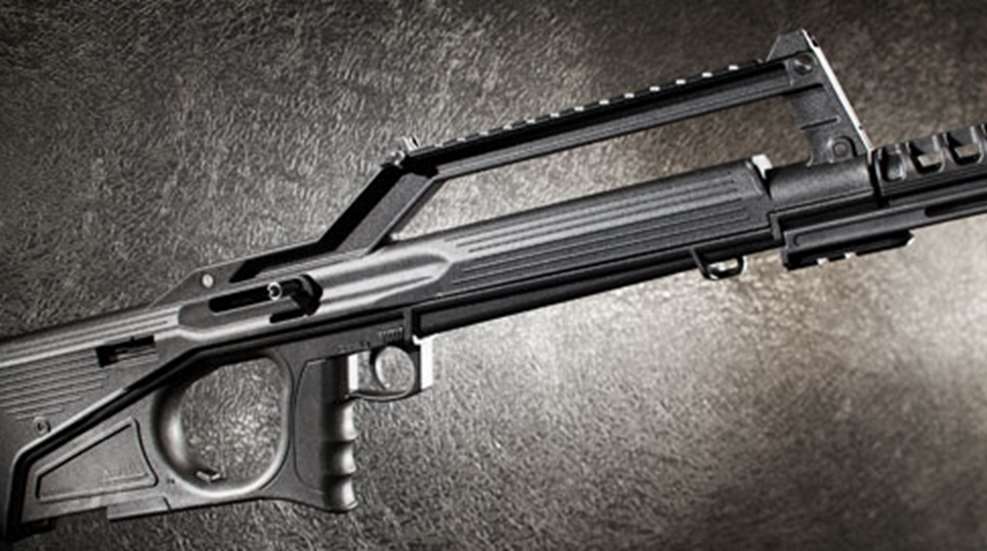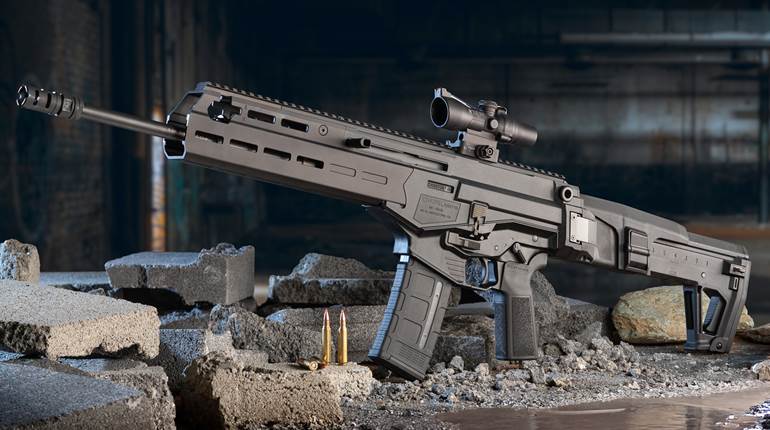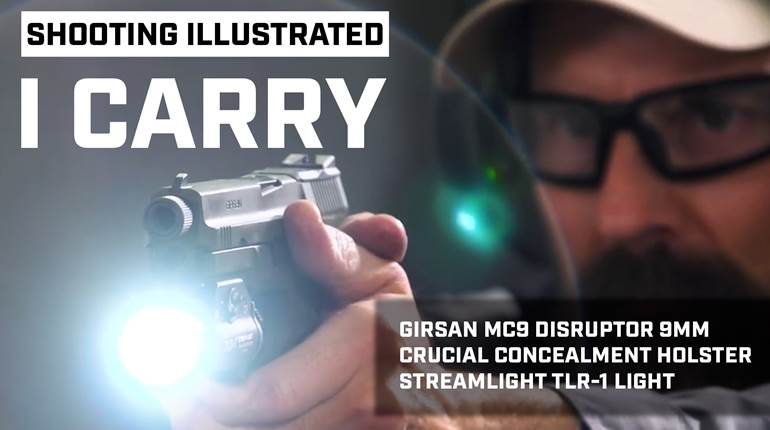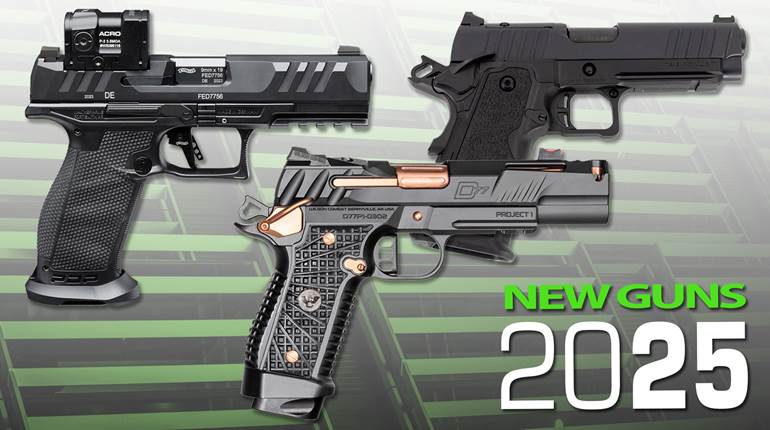
5/22/2013
European American Armory of Rockledge, Fla., has had a longstanding partnership with Italy’s Tanfoglio, having imported its Witness line of CZ-75-based center-fire pistols for many years. But the latest offering resulting from that relationship could not be more different. The Italian-produced Appeal is a blowback-operated semi-automatic rimfire rifle—available in either .22 Long Rifle, tested here, or .22 WMR. The gun is unusual in that it is a bullpup, in which the breech and fire-control components lie behind the pistol grip and trigger.
The main advantage of such a layout is that it can incorporate a comparatively long barrel in a relatively short overall package. In the Appeal, that equates to a 26 ¼ inches overall with an 18-inch barrel. In practical terms, that means the Appeal, ready to fire, is nearly as compact as some disassembled takedown rifles.
Our initial impression of the Appeal was that it exhibited a high level of manufacturing quality. Its polymer parts exhibited little flex, and steel parts had few visible tooling marks and were well-finished. In addition, the overall lines of the gun seemed to be a good example of form following function. Noteworthy features of the Appeal included an adjustable length of pull through the use of a simple buttstock spacer system and adaptability to either right- or left-handed shooters by way of an ejector, an off-side ejection port cover and an extractor whose orientation can be reversed.
The rifle’s molded polymer stock consists of upper and lower sections, the latter of which is the serialized receiver, held together by three drift pins. The upper section has a built-in stanchion that features an 8-inch section of molded-in Weaver-style rail intended for mounting optical or electronic sights. At its front is an elevation-adjustable 0.14-inch-diameter metal sight post threaded into a hexagonal metal barrel and protected by two molded-in wings. At the rear, a windage-adjustable polymer notch rides in a dovetail and can be moved left or right by turning a knurled, slotted thumbscrew. The stanchion’s length affords an 8 ¾-inch open-sight radius and allows mounting of conventional riflescopes as well. It is slightly over wide, and the notched rails are taller than on Weaver- or Picatinny-spec units, making it incompatible with most optic mounts. One exception was the Leupold Prismatic sight. EAA is working with Tangfolio to make this dimension compatible with readily available mounts in the future.
The only other functional parts contained in the upper section are the ribbed plastic buttpad and three 5/16-inch spacers, along with the ejection port cover, which is held in place by a single pin.
The lower section contains the barrel and firing mechanism. The barrel itself measured 0.478 inches in diameter at the muzzle and swells to 0.665 inches for a 3-inch section ahead of the breech that serves to center the barrel in the stock. A passageway at the section’s front serves to orient an O-ring that rides in an annular groove cut into a 0.580-inch-diameter boss on the barrel. A 2-inch-long polymer barrel support block is pinned to the breech end and has a lower lug that allows one of the three takedown pins to fix it to the lower section. An upper lug allows it to be pinned to the upper section, and round longitudinal passageways guide the bolt via its recoil spring guide and its twin stainless-steel guide rods.
The stamped steel blade ejector is pinned to the barrel support block and, along with the extractor and ejection port cover, must be flipped over and reinstalled, to change the rifle’s ejection pattern from one side to the other. The lower section also has two molded-in sling loops for carrying the gun. A short section of accessory rail under the barrel can be used for a bipod or a light, and a removable polymer flash hider slides over it and is fixed with one Allen-head screw. The flash hider incorporates another section of accessory rail so that accessories can be used whether it is in place or not.
The cast steel bolt and turned recoil spring sleeve are pinned together. The assembly contains the firing pin and spring and firing pin safety and extractor. The recoil spring rides on a steel guide rod that indexes to a hole in the lower section’s rear. The twin guide rods are inserted through and supported by passageways in the lower section’s rear and are fixed at the front by the barrel support.
A transverse sliding safety button, when pressed left to right, moves under a shelf on the polymer trigger assembly, blocking it from pivoting. The 9-inch-long stamped steel trigger bar lies along the lower section’s right side. It is drawn forward when the trigger is pulled and the safety disengaged, pivoting the sear forward and freeing the hammer, which is powered by a coil spring, to fall and strike the rear of the firing pin. A vertically oriented, plunger-style firing pin safety is simultaneously raised by a projection on the trigger bar, ensuring that the firing pin can only move forward if the trigger is pulled to the rear.
Controls consist of the aforementioned safety, located above the front of the trigger guard; a bolt lock on the lower stock’s left side above the pistol grip that can also be pressed upward to release the bolt; a magazine release at the inside lower rear of the stock’s thumbhole; and the knurled, chrome-plated cocking handle, which can be inserted into the recoil spring sleeve through slots in the upper section from either side, depending on shooter preference and independent of which side is selected for ejection. The cocking handle, which reciprocates as the action cycles, also cleverly serves double duty as an adjustment tool for the font sight.
The Appeal attracted interest from staffers who, for the most part, found it fun and easy to shoot. Several remarked that, despite the gun's unusual configuration, it pointed naturally and all controls were within easy reach. As we became accustomed to the gun, we found that magazines were most easily removed by activating the release with the off-hand thumb, allowing them to drop freely into that hand. We tested the Appeal with three different .22 Long Rifle loads at 50 yards using a Leupold Prismatic scope. Functioning throughout more than 200 rounds was flawless, and accuracy was better than expected considering the gun’s long trigger mechanism, the pull of which averaged 6 pounds, 12 ounces.
The Appeal possesses a unique—well, appeal—that is refreshing and fitting for a gun that will likely be used most for recreational plinking. Bullpup aficionados will likely gravitate to it because of its relatively low price, and other shooters should appreciate its unique appearance, compact size and high quality of manufacture. In the end, the EAA Appeal is an aptly named standout in crowded field of traditional-style semi-automatic rimfire rifles.
Importer: European American Armory Corp.: (321) 639-4842; eaacorp.com
Manufacturer: Fratelli Tanfoglio, S.n.c.
Caliber: .22 Long Rifle (tested), .22 WMR
Action Type: blowback-operated semi-automatic rimfire rifle
Receiver: polymer
Barrel: 18" steel
Rifling: six-groove, 1:15" RH twist (.22 LR); 1:14" RH twist (.22 WMR)
Magazine: 10-round detachable box
Sights: elevation-adjustable post front; windage-adjustable serrated notch rear
Trigger: two-stage; 6-lb., 12-oz. pull
Stock: two-piece molded polymer
Overall Length: 26¼"
Weight: 7 lbs., 8 ozs.
Accessories: hard case, owner’s manual, two extra magazines
Suggested Retail Price: $414 (.22 LR); $428 (.22 WMR)





































